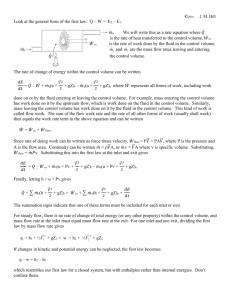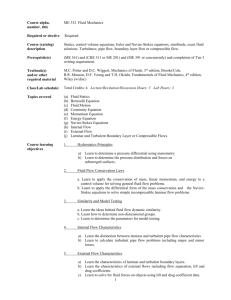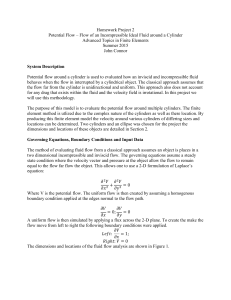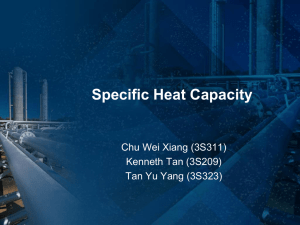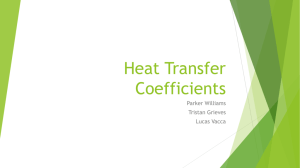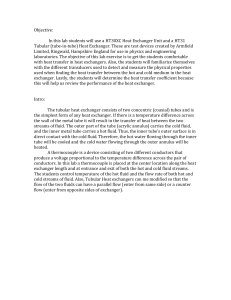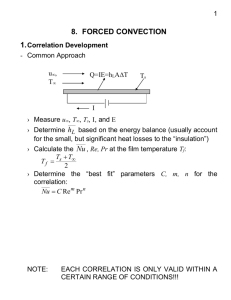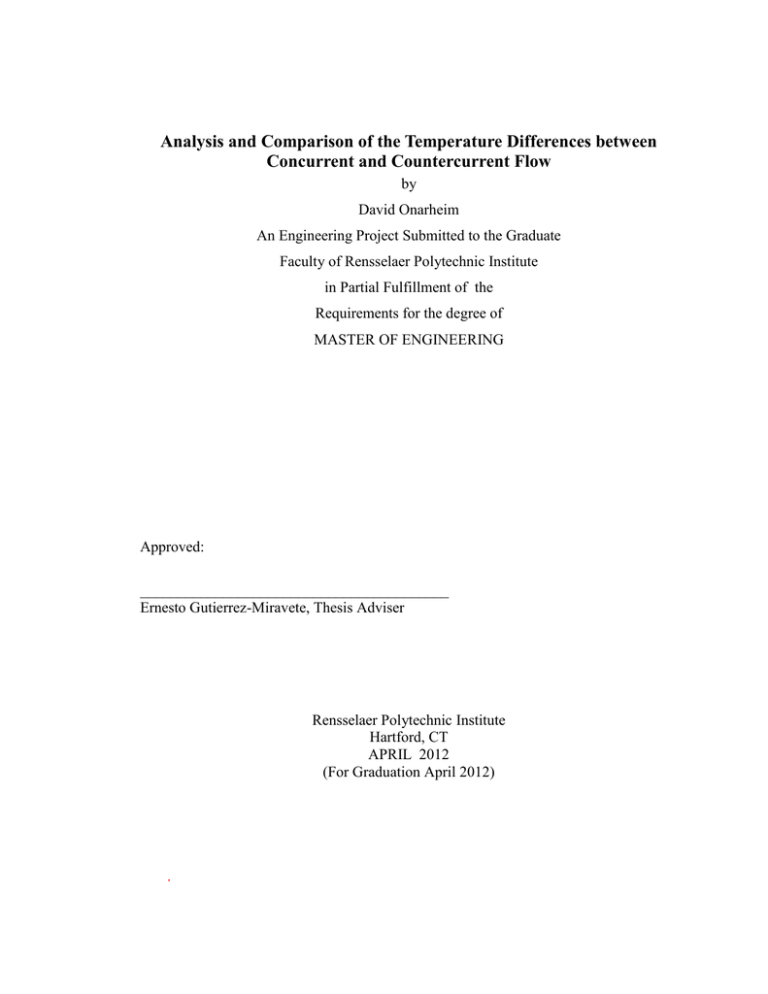
Analysis and Comparison of the Temperature Differences between
Concurrent and Countercurrent Flow
by
David Onarheim
An Engineering Project Submitted to the Graduate
Faculty of Rensselaer Polytechnic Institute
in Partial Fulfillment of the
Requirements for the degree of
MASTER OF ENGINEERING
Approved:
_________________________________________
Ernesto Gutierrez-Miravete, Thesis Adviser
Rensselaer Polytechnic Institute
Hartford, CT
APRIL 2012
(For Graduation April 2012)
.
© Copyright 2012
by
David Onarheim
All Rights Reserved
ii
CONTENTS
Analysis and Comparison of the Temperature Differences between Concurrent and
Countercurrent Flow ..................................................................................................... i
LIST OF TABLES ............................................................................................................. v
LIST OF FIGURES .......................................................................................................... vi
ACKNOWLEDGMENT ................................................................................................. vii
ABSTRACT ................................................................................................................... viii
1. Introduction and Background ...................................................................................... 1
1.1
Heat Exchanger Analysis Theory....................................................................... 1
1.1.1
Log Mean Temperature Difference ........................................................ 2
1.1.2
Heat Exchanger Effectiveness (ε) ......................................................... 2
1.1.3
Thermal Entrance in a Tube or Pipe ...................................................... 3
2. Problem Description .................................................................................................... 5
2.1
Defining Material Properties .............................................................................. 5
2.2
Methodology and Approach ............................................................................... 5
2.2.1
Finite Element Analysis ......................................................................... 5
2.2.2
Defining Variable Temperature and Velocity ........................................ 6
3. Theory of Solution ....................................................................................................... 7
3.1
The Graetz Problem Results............................................................................... 7
3.1.1
The Graetz Problem COMSOL Model .................................................. 7
3.1.2
The Graetz Problem COMSOL Mesh .................................................... 9
3.1.3
The Graetz Problem Study Results ...................................................... 11
3.1.4
The Graetz Problem Calculations ........................................................ 11
4. Results........................................................................................................................ 13
4.1
Laminar Flow in a Pipe with Axial Conduction .............................................. 13
4.1.1
Laminar Flow in a Concurrent Flow Heat Exchanger ......................... 13
4.1.2
Laminar Flow in a Counter-Current Flow Heat Exchanger ................. 13
iii
4.2
4.1.3
Laminar Flow in a Concurrent Flow Heat Exchanger with Fouling.... 13
4.1.4
Laminar Flow in a Counter-Current Flow HX with Fouling ............... 13
Turbulent Flow in a Pipe with Axial Conduction ............................................ 13
4.2.1
Turbulent Flow in a Concurrent Flow Heat Exchanger ....................... 13
4.2.2
Turbulent Flow in a Counter-Current Flow Heat Exchanger .............. 13
4.2.3
Turbulent Flow in a Concurrent Flow Heat Exchanger with Fouling . 13
4.2.4
Turbulent Flow in a Counter-Current Flow HX with Fouling ............. 13
5. References.................................................................................................................. 14
iv
LIST OF TABLES
Table 1: Graetz Problem Comparison ............................................................................ 12
v
LIST OF FIGURES
Figure 1: Basic Heat Exchanger Design ........................................................................... 2
Figure 2: Graetz Problem Temperature Profile ................................................................ 3
Figure 3: Nusselt Number for Various Pr Numbers ......................................................... 4
Figure 4: Graetz Problem Geometry................................................................................. 7
Figure 5: Graetz Velocity Profile ..................................................................................... 8
Figure 6: Graetz Temperature Profile ............................................................................... 9
Figure 7: User Defined Mesh ......................................................................................... 10
Figure 8: Graetz Problem Centerline Temperature ........................................................ 11
vi
ACKNOWLEDGMENT
I’d like to thank family and friends for supporting me during work on this project and
my master’s degree.
vii
ABSTRACT
Concentric tube heat exchangers utilize forced convection to lower the
temperature of a working fluid while raising the temperature of the cooling medium. The
purpose of this project was to use a finite element analysis program and hand
calculations to analyze the temperature drops as a function of both inlet velocity and
inlet temperature and how each varies with the other. These results were compared
between concurrent and countercurrent flow and between concurrent and countercurrent
flow with fouled piping. To determine the best heat transfer rate, both laminar and
turbulent flow was analyzed.
viii
1. Introduction and Background
There are many uses for heat exchangers from car radiators, to air conditioners,
to large condensers in power plants. But for all applications the effectiveness of these
heat exchangers are dependent on many factors. Not only does the viscosity and density
of the fluids affect the heat transfer due to being a factor of the Reynolds number and
therefore Nusselt number, but the inlet velocity (mass flow rate) and temperatures of the
fluids are proportional to the heat transfer rate.
c Th Tc
q m
(1)
This project looks at the heat exchange between fluids in concentric tube heat
exchangers. In this type of heat exchanger, forced convection is caused by fluid flow of
different temperatures passing parallel to each other separated by a boundary, pipe wall.
Several assumptions will have to be made to make it easier to focus on the inlet velocity
and temperature dependence on heat exchanger temperature drop. Not only will the
viscosity and density remain constant for the calculations, but specific heat and overall
heat transfer coefficients will be assumed constant. Any effects from potential and
kinetic energy are assumed negligible.
1.1 Heat Exchanger Analysis Theory
Two types of analysis for parallel flow heat exchangers to determine temperature
drops are the log mean temperature difference and the effectiveness-NTU method. Both
methods will be attempted to be used for the project. The equation for heat transfer using
the log mean temperature difference becomes:
q UATlm UA
T2 T1
ln T2
T
1
(2)
where the only change for parallel and countercurrent flow is how the delta-T’s are
defined. The NTU (number of transfer units) method uses the effectiveness number of
the type of heat exchanger to determine the amount of heat transfer.
q c min Th ,i Tc ,i
The effectiveness of the types of heat exchangers is as follows:
1
(3)
Parallel Flow:
Counter Flow:
1 exp[ NTU (1 C r )]
1 Cr
(4)
1 exp[ NTU (1 Cr )]
forCr 1
1 Cr exp[ NTU (1 Cr )
(5)
In general the heat flux is comprised of three factors: the temperature difference,
the characteristic area, and an overall heat transfer coefficient. An approximate value for
the transfer coefficient U (W/m^2 k) is 110-350 for water to oil. In the case where
fouling is present on the heat exchanger tubes, the following can be used in the case of
tubular heat exchangers:
UA
R f ,i
1
hi Ai
Ai
ln(
1
Do
(6)
)
R f ,o
Di
1
2kL ho Ao
Ao
Rf is defined as the fouling factor with units of m^2 k/w. An approximate value of .0009
is used for fuel oil, while .0001 - .0002 is used for seawater and treated boiler feedwater.
Figure 1: Basic Heat Exchanger Design
1.1.1
Log Mean Temperature Difference
1.1.2
Heat Exchanger Effectiveness (ε)
The effectiveness ε is the ratio of the actual heat transfer rate to the maximum
possible heat transfer rate:
qactual
,0 1
q max
2
(7)
1.1.3
Thermal Entrance in a Tube or Pipe
Figure 2: Graetz Problem Temperature Profile
The development of fluid flow and temperature profile of a fluid after undergoing a
sudden change in wall temperature is dependent on the fluid properties as well as the
temperature of the wall. This thermal entrance problem is well known as the Graetz
Problem. For incompressible Newtonian fluid flow, the equation of energy becomes:
𝐷𝑇
𝜌𝑐𝑝 𝐷𝑡 = 𝑘∇2 𝑇 + 𝜑
(8)
Neglecting dissipation and any conduction axially, equation 8 reduces to the following:
𝜕𝑇
𝑢 𝜕𝑥 =
𝛼 𝜕
𝑟 𝜕𝑟
𝜕𝑇
(𝑟 𝜕𝑟 )
(9)
The velocity distribution is assumed to be known when using this equation and can be
several different types of flow. For low prandtl number materials such as liquid metals
the temperature profile (T) will develop faster than the velocity profile (u) and u will be
constant. For high prandtl number materials such as oils or when the thermal entrance
(sudden change in wall temperature) is fairly far down the entrance of the duct/ tubing
𝑟2
𝑢 = 2𝑢̅(1 − 𝑟 2 ). The velocity profile can also be developing and can be used for any
0
prandtl number material assuming the velocity and temperature profiles are starting at
the same point.
There have been numerous analytical solutions developed for the Graetz problem
with different types of flow. For laminar flow with a developing velocity profile, the
mean nusselt number can be approximated based on the relationship illustrated below
between the log mean nusselt number and the graetz number for various prandtl
numbers.
3
Figure 3: Nusselt Number for Various Pr Numbers
An approximation for the mean nusselt number was given by Hausen (1943) for fluid
with their prandtl number >1 (especially for use with oils). This is given by equation 10
below.
𝑁𝑢𝑚 = 3.66 +
4
.075⁄ ∗
𝐿
1+.05⁄ 2
𝐿∗3
(10)
2. Problem Description
For this project, fully developed laminar and turbulent incompressible fluid flow
was analyzed in three heat exchanger cases: parallel flow, countercurrent flow, and flow
in a fouled heat exchanger. The resulting temperature difference was compared and
determined as a function of the inlet velocity and inlet temperatures. The overall
objective for this project was to determine the max temperature difference in these cases
for both laminar and turbulent flow for a variety of flow rates and inlet temperatures. To
simplify the number of variables, water and oil were chosen as the fluids to maintain
viscosities and densities of the fluids constant. The type of heat exchanger used was of
concentric tube design. Water was the cooling medium and oil the working fluid.
2.1 Defining Material Properties
Water was used as the base fluid flowing through tube or pipe. Its material
properties were derived from tables based on the temperature which was being used in
the model. The material was defined in COMSOL using its material browser, but certain
properties were defined by the user prior to computing the model results. These
properties were: thermal conductivity, density, heat capacity at constant pressure, ratio
of specific heats, and dynamic viscosity.
2.2 Methodology and Approach
2.2.1
Finite Element Analysis
A finite element analysis was done using COMSOL for the fluid flow and
convective heat transfer. A 2D axisymmetric model was chosen to depict the tubing the
fluid was flowing through. The type of physics to be applied was then added. For the
baseline model (the graetz problem) the physics used was laminar fluid flow and then
non-isothermal flow was chosen. This allowed for definition of not only the fluid
parameters but also the heat transfer of the constant wall temperature to the fluid. The
third model introduced a second pipe concentric to the first and was analyzed for fluid
flow in the same direction. The fourth model reversed the fluid flow for the cooling
medium, which was chosen as water. The material library was used for definition of
properties for oil and water. The fifth and sixth models added on to the second and third
5
models a layer of fouling for both types of flow and determined the effect on not only
the flow but the resultant temperature differences. These models were repeated using
turbulent flow which added complexity to each model. Post-processing plots developed
in COMSOL were used for analysis. In addition to this, the COMSOL information was
exported to excel to better compare and analyze the data. Hand calculations for the
temperature differences were also done to verify results.
2.2.2
Defining Variable Temperature and Velocity
6
3. Theory of Solution
3.1 The Graetz Problem Results
To begin the COMSOL analysis of temperature difference in fluid flow the base
condition must first be analyzed. The first condition is that of fluid passing through a
tube with a constant wall temperature, as described before this is known as the Graetz
problem. A base model was run in COMSOL and the analysis was compared to hand
calculations to verify. The initial conditions of the problem were as follows:
L=1.0m, D=0.1m, k=.64, µ=.000547 Pa.s, ρ=988 kg/m^3, Cp=4181 J/KgK
3.1.1
The Graetz Problem COMSOL Model
As previously described, the physics used for modeling was non-isothermal
laminar flow. The water was selected to be flowing through a tube or pipe of length 1m
with a diameter of .1m. The inlet flow of the water was set initially at .0001 m/s and
varied for 2 other cases: .01 m/s and .001 m/s. The temperature of the water flowing
into the tubing was set at 50 C or 323.15 K while the wall temperature remained constant
at 30 C or 303.15 K. This temperature difference was also varied for 2 other cases. The
figure below shows the geometry of the model in COMSOL.
Figure 4: Graetz Problem Geometry
7
The material properties of the fluid were then defined. Water at 50 C was used
and the properties used for temperature determination were user defined. The physics
used was non-isothermal flow and laminar flow and heat transfer nodes were applied to
define the fluid flow as well as the heat transferred from the constant wall temperature to
the water. For fluid flow the inlet and outlet points of flow were defined with the water
velocity defined at the inlet point. For heat transfer, the temperature of the water flowing
at the inlet was defined as well as the temperature of the wall. The outlet of fluid flow
was also defined as outflow in terms of the heat transfer physics. After initializing a
mesh of the model, results were obtained for not only the velocity profile but also the
temperature profile.
Figure 5: Graetz Velocity Profile
8
Figure 6: Graetz Temperature Profile
3.1.2
The Graetz Problem COMSOL Mesh
Initially the physics controlled mesh was used in COMSOL but looking at the
study results it was discovered that the results were dependent upon the refinement of
the mesh and the initial values tab of the COMSOL model. The initial values are defined
to only be an initial guess for the final solution derived by the non-linear solver in
COMSOL. However, it was found that varying the temperature in this initial values tab
would vary the centerline outlet temperature even though the temperature of inlet flow
and surface temperature were previously defined. It was also discovered that the initial
tolerance of 10^-3 as defined by COMSOL allowed for a very large variance in the
outlet temperature just by changing the refinement of the model. Ideally refining the
model should change the value slightly as the model becomes more refined since more
elements are added to the mesh, the temperature being solved for should become closer
and closer to the desired value. However by starting at the extremely coarse and going to
the fine mesh, the outlet temperature changed by almost 10 degrees and the change was
not linear.
To streamline the results and take out the uncertainty that was being created by
changing the mesh refinement, the tolerance of the solver was changed to 10^-4 and a
9
different type of mesh was created. Instead of using the triangular type elemental mesh
which COMSOL automatically defines when the physics controlled mesh is selected, the
user controlled mesh option was used and a free quad mesh was defined. This allowed
for more of a rectangle shape to the mesh elements along the length of the tubing toward
the middle of the flow. Along the wall of the tubing boundary layer meshing was added
which refined the mesh elements and added extra elements along the wall where the
temperature and velocity profiles are developing and there is more change to the flow at
this point. This allows for COMSOL to have the solver focus more on the boundary that
has complicated change to it than on the steady flow in the middle of the tubing. Figure
7 shows an example of this mesh with the additional layers applied around the wall of
the tubing.
Figure 7: User Defined Mesh
It took several iterations of attempting to find the best mesh to yield the best result.
Ultimately as the number of elements increases the outlet temperature on the centerline
should level out and gradually approach a certain value instead of varying higher and
lower around several values. By changing the number and thickness of the boundary
layers a more accurate mesh was able to be obtained.
10
3.1.3
The Graetz Problem Study Results
Using COMSOL’s post-processing capabilities, a 1D line graph was plotted
along the center of the tubing to track the temperature as it changes along the center of
the tubing. Figure 7 shows the temperature trend as the fluid cools from its inlet
temperature to near the constant wall temperature.
Figure 8: Graetz Problem Centerline Temperature
To determine the outlet temperature of the center of flow a point evaluation was
done under the derived values tab of the post-processor results of the model. This
yielded 305.3221 K. In order to verify the results, the velocity was changed at the inlet
of the tube and compared to hand calculations for both .001 m/s and .01 m/s inlet
velocity.
3.1.4
The Graetz Problem Calculations
The outlet temperature of the fluid is determined by using the mean nusselt
number of the fluid flow. The nusselt number approximation initially used was eq X
from White’s Viscous Fluid Flow and proposed by Hasusen (1943) for PR>1. First the
Reynolds number is calculated for the initial conditions. For the purpose of analysis the
flow is considered incompressible Newtonian flow.
𝑅𝑒 =
𝜌𝑉𝐷
𝜇
=
(988)(.0001)(.1)
11
(5.47𝑥10−4 )
= 18.062
(11)
The prandtl number is calculated using the material properties of water at the inlet
temperature.
𝑃𝑟 =
𝐶𝑝 𝜇
𝑘
=
(4181)(5.47𝑥10−4 )
.64
= 3.57
(12)
The dimensionless length value is defined as
𝐿
(1)
𝐿∗ = 𝐷𝑅𝑒𝑃𝑟 = (.1)(18.062)(3.57) = .15508
(13)
The outlet temperature is defined as
𝑇𝑚 (𝐿) = 𝑇𝑤 − (𝑇𝑤 − 𝑇𝑜 ) ∗ 𝑇𝑚∗ (𝐿)
(14)
Since there is a relationship between 𝑇𝑚∗ (𝐿) and the mean nusselt number, if the
nusselt number is obtained from the approximation equation, the outlet temperature can
then be determined. Using equation 10, the nusselt number is calculated.
𝑁𝑢𝑚 = 3.66 +
.075⁄ ∗
𝐿
1+.05⁄ 2
= 3.66 +
𝐿∗3
−1
.075⁄
.15508
1+.05⁄
.155082/3
= 4.0722
∗
𝑁𝑢𝑚 = 4𝐿∗ 𝑙𝑛𝑇𝑚∗ (𝐿) ∴ 𝑇𝑚∗ (𝐿) = 𝑒 (−4𝐿 𝑁𝑢𝑚) = .07997
(15)
(16)
𝑇𝑚 (𝐿) = 𝑇𝑤 − (𝑇𝑤 − 𝑇𝑜 ) ∗ 𝑇𝑚∗ (𝐿) = 30 − (30 − 50) ∗ (. 07997)
𝑇𝑚 (𝐿) = 31.5994 C = 304.7494 K
(17)
This was then compared to the centerline temperature of the fluid at the end of
the tubing (at z-=1.0m) and apercent error was calculated between the expected and
actual (COMSOL value). Table 1 shows this particular case as well as 2 other cases. The
inlet velocity was varied to .001 and .01 m/s and the centerline temperature obtained
both by hand and by COMSOL. Overall the derived values of the outlet temperature are
all near the values of the COMSOL model with less than 2% error. The Hausen equation
is noted to have an approximation error of 5%.
Inlet V
(m/s)
0.0001
0.001
0.01
Inlet Temp
(C)
50
50
50
Wall Temp
(C)
30
30
30
Expected Value Calc (K)
304.7494
316.646
317.644
COMSOL Value (K)
305.3221
321.9023
323.0481
% Error
0.187572
1.632887
1.672847
Table 1: Graetz Problem Comparison
Several other numerical methods were attempted in order to create the best
numerical solution for the Graetz problem underneath these initial conditions.
12
4. Results
4.1 Laminar Flow in a Pipe with Axial Conduction
4.1.1
Laminar Flow in a Concurrent Flow Heat Exchanger
4.1.2
Laminar Flow in a Counter-Current Flow Heat Exchanger
4.1.3
Laminar Flow in a Concurrent Flow Heat Exchanger with Fouling
4.1.4
Laminar Flow in a Counter-Current Flow HX with Fouling
4.2 Turbulent Flow in a Pipe with Axial Conduction
4.2.1
Turbulent Flow in a Concurrent Flow Heat Exchanger
4.2.2
Turbulent Flow in a Counter-Current Flow Heat Exchanger
4.2.3
Turbulent Flow in a Concurrent Flow Heat Exchanger with Fouling
4.2.4
Turbulent Flow in a Counter-Current Flow HX with Fouling
13
5. References
[1] Beek, W.J., K.M.K. Muttzall, and J.W. van Heuven. Transport Phenomena. 2nd ed.
New York: John Wiley & Sons, Ltd., 1999.
[2] Bird, Byron R., Warren E. Stewart, and Edwin N. Lightfoot. Transport Phenomena.
Revised 2nd ed. New York: John Wiley & Sons, Inc., 2007.
[3] Blackwell, B.F. “Numerical Results for the Solution of the Graetz Problem for a
Bingham Plastic in Laminar Tube Flow with Constant Wall Temperature.”
Sandia Report. Aug. 1984.
[4] Conley, Nancy, Adeniyi Lawal, and Arun B. Mujumdar. “An Assessment of the
Accuracy of Numerical Solutions to the Graetz Problem.” Int. Comm. Heat Mass
Transfer. Vol.12. Pergamon Press Ltd. 1985.
[5] Kays, William, Michael Crawford, and Bernhard Weigand. Convective Heat and
Mass Transfer. 4th ed. New York: The McGraw-Hill Companies, Inc.,
2005.
[6] Lemcoff, Norberto. “Heat Exchanger Design.” Groton. 10 July 2008.
[7] Lemcoff, Norberto. “Project: Heat Exchanger Design.” Groton. 17 July 2008.
[8] Sellars J., M. Tribus, and J. Klein. “Heat Transfer to Laminar Flow in a Round Tube
or Flat Conduit—The Graetz Problem Extended.” The American Society of
Mechanical Engineers. New York. 1955.
[9] Subramanian, Shankar R. “The Graetz Problem.”
[10]Valko, Peter P. “Solution of the Graetz-Brinkman Problem with the Laplace
Transform Galerkin Method.” International Journal of Heat and Mass Transfer
48. 2005.
[11]White, Frank. Viscous Fluid Flow. 3rd ed. New York:
Companies, Inc., 2006.
The McGraw-Hill
[13] W.M Kays and H.C. Perkins, in W.M. Rohsenow and J.P Harnett, Eds., Handbook
of
Heat Transfer, Chap. 7, McGraw-Hill, New York, 1972.
[14] TBD
14

